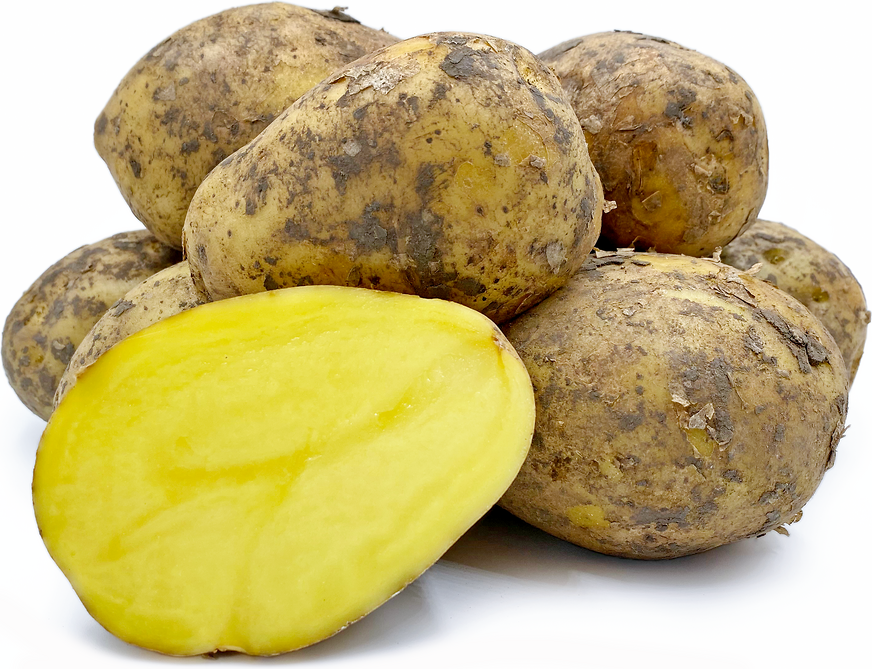


Baron Potatoes
Estimated Inventory, lb : 0
Description/Taste
Baron potatoes are large tubers with an oval, round, to oblong shape. The skin is semi-thick, ranges from smooth to slightly rough and flaky, and is golden yellow with some dark brown spots. The skin may also bear some shallow to medium-set eyes that are tinged with shades of pink or red. Underneath the surface, the flesh is dense, firm, and dark yellow. Baron potatoes contain high starch content, and when cooked, the flesh becomes fluffy, soft, and tender with a mild, earthy flavor.
Seasons/Availability
Baron potatoes are harvested in the fall through early winter in Asia and are available year-round when properly kept in cold storage.
Current Facts
Baron potatoes, botanically classified as Solanum tuberosum, are an early-ripening, yellow variety found in Siberia that belongs to the Solanaceae or nightshade family. There are over twenty varieties of potatoes growing in Siberia, which is a region spanning across northern Asia, and many of the varieties are often labeled in markets under the general name of Siberian potatoes. In Russia, Baron potatoes are considered to be one of the most popular table varieties, which is a term given for cultivars used for everyday culinary applications, and the tubers are commonly found throughout local markets. The variety was created in the early 2000s at the Ural Scientific Research Institute of Agriculture and were developed for their resistance to disease, tolerance to cold weather, good storage qualities, and transportability. Baron potatoes are grown both commercially and in home gardens and are favored for their light, fluffy texture and earthy flavor.
Nutritional Value
Baron potatoes are an excellent source of vitamin C, which is an antioxidant that can help protect and boost the immune system. The tubers also contain fiber, potassium, some vitamin B6, and iron.
Applications
Baron potatoes are best suited for cooked applications such as mashing, boiling, and frying. The tubers are considered a versatile variety that can be used in everyday cooking and are popularly boiled, mixed with herbs, and served as a side dish, cubed and tossed into soups and stews, mashed for a soft, fluffy consistency, or sliced and fried. In Russia, Baron potatoes can be used in draniki, which are potato pancakes made with flour, onions, eggs, and grated potatoes. They are also used in shangi, which are pastries filled with a mixture of eggs, butter, and potatoes, or in zapekanka, which is a mashed potato dish sometimes served with minced meat and sour cream. Baron potatoes pair well with mushrooms, corn, carrots, peas, dill pickles, onions, green onions, herbs such as dill, rosemary, sage, or thyme, cream, meats such as ham, sausage, and beef, eggs, and cheeses such as mozzarella, swiss, and cheddar. The tubers will keep 1-2 weeks when stored at room temperature. If stored in a cool, dry, and dark location with the temperature maintained, the potatoes can keep 2-3 months or longer.
Ethnic/Cultural Info
In the late 19th century, chef Lucien Olivier created a new salad recipe that was tossed with a secret sauce at his restaurant, “The Hermitage,” in Moscow, Russia. This salad quickly gained widespread notoriety for its flavors, and even Tsar Alexander II visited the restaurant to try the dish. Legend has it that Olivier would keep all the salad ingredients locked in a separate room in the restaurant so that the recipe would not be leaked to the public. Olivier took the recipe to his grave, and due to its popularity, many chefs tried to recreate the salad after his passing, eventually creating what is known as the Olivier or Russian salad in the modern-day. Today Olivier salad has many different variations with base ingredients, including potatoes such as the Baron potato, peas, eggs, carrots, onions, meat such as ham or bologna, pickles, and mayonnaise. The dish is traditionally served in large batches during new year celebrations, which is considered to be one of the most popular holidays in Russia during the winter season and is also served the next morning after festivities.
Geography/History
Baron potatoes were developed at the Ural Scientific Research Institute of Agriculture in the early 2000s in Russia. The variety was then listed in the Russian Federation’s State Register of Plant Production in 2006, and the tubers are primarily grown in the Far Eastern, West Siberian, and Volga-Vyatka regions of Russia. Baron potatoes are found at local markets in Russia and in neighboring countries such as Kazakhstan and are also commonly grown in home gardens throughout northern Asia.











